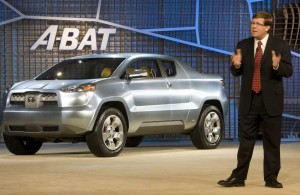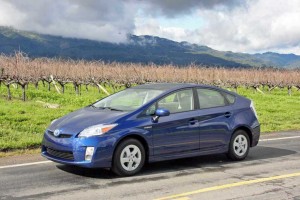
Toyota Motor Sales USA's top gaijin, Jim Lentz, revealing the A-BAT concept car.
By all measures, it should have been a great year for Toyota Motor Company. The Japanese automaker wrapped up 2008 fulfilling its long-held goal of besting its American rival, General Motors Corporation, to become the world’s best-selling automaker, a push driven, in part, by the huge success of its Prius hybrid-electric vehicle.
But as the new year began, things didn’t quite look so good. In the critical U.S. market, Toyota began posting sales declines nearly as severe as GM – with Prius sales off by more than two-thirds of its mid-’08 peak. That, in turn, has helped the maker rack up global losses that are expected to top $4 billion for the fiscal year, which wrapped up on March 31st.
While Toyota has shaken up its corporate management back in Japan, much of the effort of turning things around has been focused on the wide open U.S., which accounts for the bulk of its profits. No wonder that Jim Lentz, president of Toyota Motor Sales USA is working a near 24/7 schedule. TheDetroitBureau.com’s Paul A. Eisenstein caught up with the surprisingly youthful senior executive as he raced from a product unveiling, at the New York International Auto Show, to catch yet another flight.

The 2010 Toyota Prius goes to market at the same time demand for hybrids has collapsed.
TDB: Virtually everyone expected a great year for Toyota, especially in the U.S., where, at one point, you had barely a day’s supply of Prius hybrids – compared to the normal, 60-day dealer inventory. What happened?
Lentz: Last year started out okay. We didn’t realize we were already in recession until everything fell off the table. Then, fuel prices soared. Lehman Brothers went broke, triggering the credit crisis. Everything came unbalanced and we had to respond quickly to deal with all the cars piling up.
TDB: Just how bad a situation is it out there? Is this recession worse than others we’ve seen for the auto industry?
Lentz: If you look at the recessions of the ’70s, ’80s and ’90s, they’ve all seen a peak-to-trough decline in sales of 20 to 25%. And until last year, that’s about what we expected this time, the 17-plus million peak, this decade, falling to around 13.2 million. But this year, we’re not even operating at (an annualized sales rate of) 10 million. That was impossible for anyone to forecast.
TDB: So, how do you respond?
Lentz: Step by step. You cut from two (assembly) lines to one, reduce the number of hours everyone works from 80, over two weeks, to 72, you freeze hiring and you freeze executive bonuses. We’re taking the view of shared sacrifices.
TDB: When can we expect a recovery – and how strong is it likely to be, considering many analysts believe it won’t come anywhere near the 17-million peak of just a few years ago?
Lentz: We’re keeping an eye on the trendline. It’s driving by things like the birth rate and immigration, and the number of cars per household. Could people cut back on the number of cars they own? We could see a fluctuation because of the cost of adapting to higher fuel prices. But there’s enough pent-up demand that we think the future is very, very bright.
TDB: Which means?
Lentz: We see a trendline of 15 to 16 million by 2014 or ’15.
TDB: But isn’t it possible that people might, as you suggested, cut back on the number of cars per household, or just hold onto vehicles longer? After all, cars are now so reliable they can last longer. And with younger buyers moving back into cities, as you suggested during your Tuesday news conference, maybe they don’t have room for as many?
Lentz: The universe of cars in the U.S. is 250 million, but when you consider cars six years or newer, that falls to 80 million, and (because of the sales slump), that will soon drop to 70 million. That’s a substantial drop in the number of high-demand used vehicles. And that should drive a revival in sales of new vehicles.
As for urbanization, we expect to see people switch, say, from a big SUV and midsize car to something like our RAV4 (compact crossover) and the IQ (a microcar concept shown at the NY Auto Show).
TDB: Are you committed to building the little IQ (which is only slightly larger than the Smart fortwo)?
Lentz: It’s something we still have to test for the U.S., but it’s selling well in Europe and Japan. We’ll see more manufacturers consider that segment. As we see urbanization continue, along with traffic congestion, the architecture of cities may change, and the architecture of automobiles may change to something more like the Segway. They won’t be automobiles, but urban transportation devices.
TDB: Could we see more non-traditional players, like Segway, or the EV maker, Tesla Motors, enter the market?
Lentz: That’s a very American solution to the problem of innovation. If they can pull it off, they can change the industry, but it’s tough to crack in with all the regulations and costs facing the auto industry. We haven’t seen many new makers in a long time… but I think some will make it.
TDB: Last June, Toyota sold about 22,000 Prius hybrids in the U.S. This year, it’s been running barely 6,000 a month. What happened? And will the debut of the third-generation Prius help?
Lentz: That’s being driven by the overall decline in the U.S. market size and fuel prices. When we sold 22,000, gas was $4 a gallon and the industry was nearly 16 million. Long-term, the trend in fuel prices is up, not down, so having a new Prius will expand overall demand. We’re still bullish.

Excellent info, especially considering I was looking at this brand for my next car.